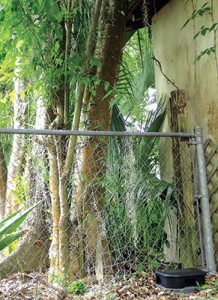
Plants and shrubs touching a structure become a superhighway for assorted rodents, small animals and insects. Photo: Jeff McGovern
In North America, we usually soften the architectural lines of our homes and buildings with landscape plants and shrubs. Rarely is consideration given to the size the plants and shrubs will reach at maturity, however. Sometimes they end up growing too close to a structure, and end up making direct contact with it.
Plants and shrubs touching a structure become a superhighway for assorted rodents, small animals and insects. Mulch, which often accompanies plants and shrubs, provide harborage for these pests — right next to a building.
Look at the picture. Where is the bait station? Even if the branches are not touching the sides, but hang over the roof, rats and mice can easily avoid the station, climb the tree and drop onto the roof.
What to do? First, prune and clear away any greenery touching the structure to about 24 in. away from it. Clear mulch, branches and climbing plants to the same distance. Use a rodent repellent gel labeled for trees, and band the trees’ trunks. This works especially well on tall trees, where trimming overhanging branches is impractical.
Set up interventions (snap traps, stations, glue boards, etc.) in drop zones on the roof and ground. Some rodents live their entire lives without touching the ground. A sound pest professional understands the value of looking up.
You can reach Jeff and Kate McGovern at jeffreymcgovern@mindspring.com.
Leave A Comment